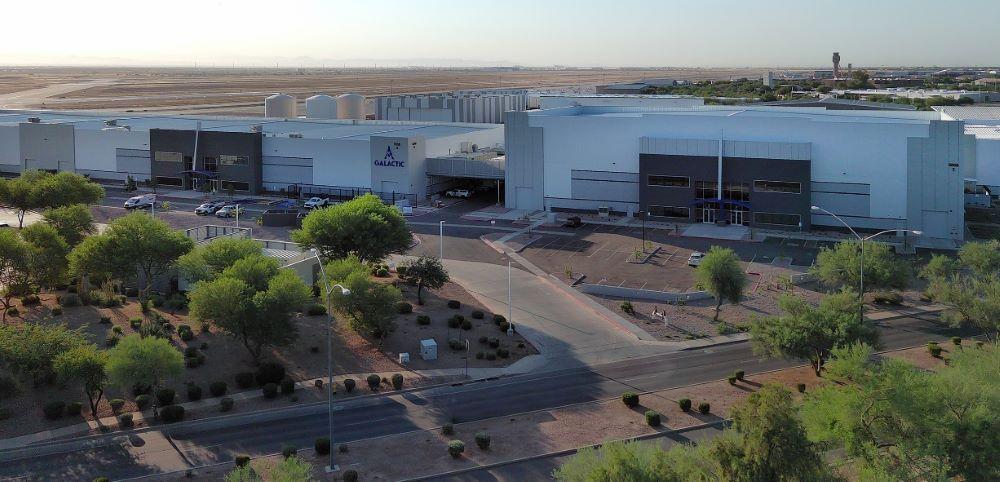This article is published in Aviation Week & Space Technology and is free to read until Aug 15, 2024. If you want to read more articles from this publication, please click the link to subscribe.

Virgin Galactic took possession of its new Phoenix final assembly site for the Delta class spaceplane in July.
COLORADO SPRINGS—Suborbital space tourism company Virgin Galactic has revealed new details of its long-term business model as part of efforts to bolster market confidence during an extended break between spaceflights, while it continues development of the next-generation Delta-class spaceplane version.
The company aims to resume passenger flights with the first of the new vehicles in 2026, and says revenues are expected to grow rapidly in the following years to around $450 million annually when both spaceplanes are flying.
With a project turnaround time between flights of three days compared to a month for the previous spaceplane Unity, which made its seventh and final commercial flight in June, the Deltas are expected to deliver a steady-state operating capacity of approximately 125 spaceflights per year, carrying around 750 passengers.
At the current pricing of $600,000 per seat, this translates to annualized revenue of around $450 million, Virgin Galactic says. With plans to add two additional spaceplanes and a second carrier aircraft around 2030, it adds that flight capacity is expected to increase to roughly 275 flights with more than 1,600 passengers per year. “This rate will translate into revenues growing to nearly $1 billion,” the company adds.
Virgin Galactic believes the total addressable space passenger market is a global population of around 30,000 high-net-worth individuals with liquid assets of at least $10 million. Given the projected annual 8% growth rate and the maximum capacity of the fleet, Virgin says it will be tapping into only around 1% of global demand.
Profits have the potential to grow to nearly $0.5 billion with earnings before interest and taxes margins expected to approach 45 to 50%, it adds. “This estimated margin expansion is due to much of the cost structure of the business remaining fixed, even as frequency of flight increases,” Virgin Galactic says.
Beyond this, the company plans to open a second spaceport toward the end of the decade, which combined with the additional spaceships and mother ships “could enable combined revenues of around $2 billion per year at current prices. A business model with that magnitude of profit growth is extraordinary,” Virgin Galactic CFO Dou Ahrens said during the company’s second-quarter earnings call on Aug 7.
The company hopes a more detailed explanation of its business plan will give investors a better perspective of its longer-term profit potential in a new area of the space market. Just three months ago, Virgin Galactic saw its shares almost booted off the New York Stock Exchange because the stock price fell below $1 for too long. Despite efforts to shore up finances up with a 1-for-20 reverse stock split in June, shares have continued to lose value—plummeting over time from a high of around $1,100 three years ago to just more than $5 today. “We have an innovative business model that is not yet known by many, and we believe there is a gap between about how the public market understands our business relative to the value we are creating within the company,” Ahrens says.
For now, however, the main focus is on starting production of the new spaceplanes and minimizing costs and losses while the revenue-earning flights remain grounded. Citing the company’s “tenacious fiscal discipline” during this phase, Virgin Galactic CEO Michael Colglazier says the company is about to pivot from the design of the Delta vehicles to “the build and test phases of our production spaceships, which remain on track to enter commercial service in 2026.”
Tooling has been built and released in readiness for shipping to Bell Textron and Qarbon Aerospace, which will make major structural subassemblies. Bell will supply the vehicle’s feathering system and flight control surfaces while Red Oak, Texas-based structures specialist Qarbon Aerospace will produce the fuselage and wing.
Virgin Galactic is responsible for the overall system architecture, design authority for all components, and the final assembly, integration, checkout, and acceptance testing of the vehicles, which will be conducted at the company’s new facility in Phoenix. Virgin Galactic took ownership of the site in July.
Fabrication of the first parts for the initial Delta vehicle is due to ramp up in the fourth quarter, with parts arriving for final assembly of the spaceplane starting in the first half of 2025. Virgin anticipates a relatively fast assembly process with rollout and ground testing in the second half of next year, clearing the way for flight tests in early 2026.
“We do still expect 2024 to be the highest spending year,” Ahrens says. “You’ll see things ramping down in the second and third quarter of next year.”
With around $821 million in cash and securities as of June 30, the company says it has sufficient resources on the balance sheet to see through the completion of the design, building and testing of the Delta vehicles.
For the second quarter of 2024, Virgin Galactic reported almost $4 million in revenue, compared with $2 million for the same 2023 period. Net loss was $94 million against a loss of $141 million in the second quarter of 2023, driven by lower operating expenses.





